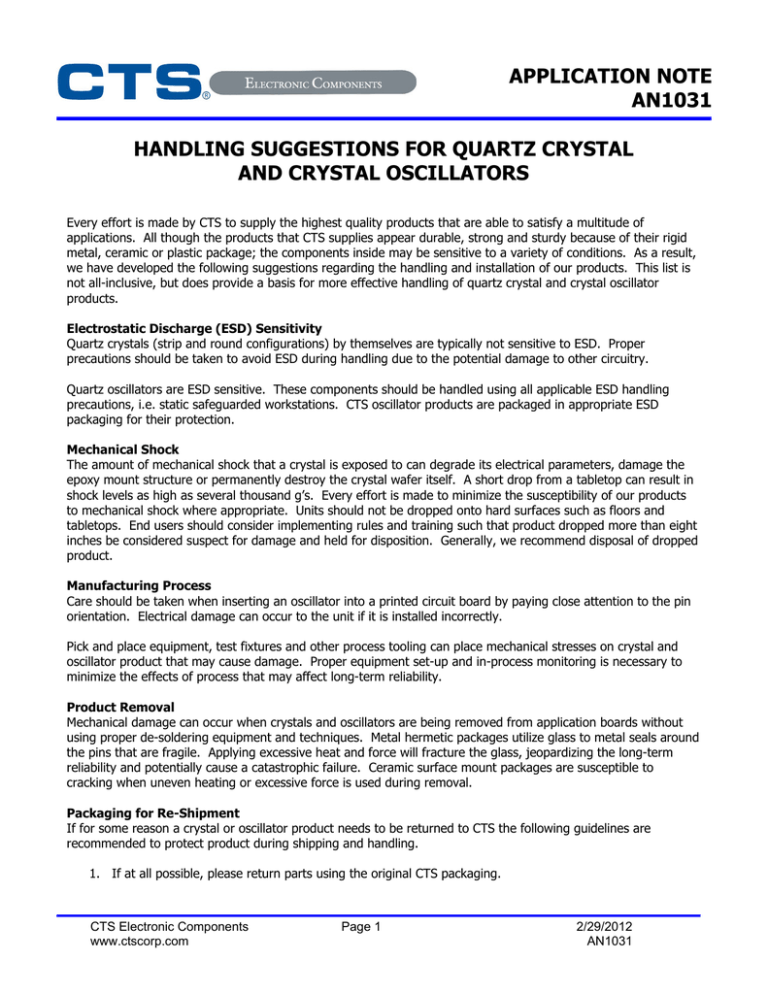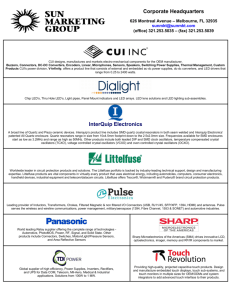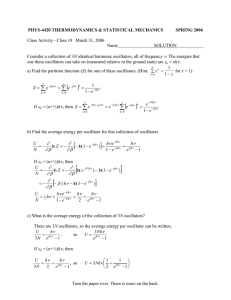application note an1031 handling suggestions for quartz
advertisement

APPLICATION NOTE AN1031 HANDLING SUGGESTIONS FOR QUARTZ CRYSTAL AND CRYSTAL OSCILLATORS Every effort is made by CTS to supply the highest quality products that are able to satisfy a multitude of applications. All though the products that CTS supplies appear durable, strong and sturdy because of their rigid metal, ceramic or plastic package; the components inside may be sensitive to a variety of conditions. As a result, we have developed the following suggestions regarding the handling and installation of our products. This list is not all-inclusive, but does provide a basis for more effective handling of quartz crystal and crystal oscillator products. Electrostatic Discharge (ESD) Sensitivity Quartz crystals (strip and round configurations) by themselves are typically not sensitive to ESD. Proper precautions should be taken to avoid ESD during handling due to the potential damage to other circuitry. Quartz oscillators are ESD sensitive. These components should be handled using all applicable ESD handling precautions, i.e. static safeguarded workstations. CTS oscillator products are packaged in appropriate ESD packaging for their protection. Mechanical Shock The amount of mechanical shock that a crystal is exposed to can degrade its electrical parameters, damage the epoxy mount structure or permanently destroy the crystal wafer itself. A short drop from a tabletop can result in shock levels as high as several thousand g’s. Every effort is made to minimize the susceptibility of our products to mechanical shock where appropriate. Units should not be dropped onto hard surfaces such as floors and tabletops. End users should consider implementing rules and training such that product dropped more than eight inches be considered suspect for damage and held for disposition. Generally, we recommend disposal of dropped product. Manufacturing Process Care should be taken when inserting an oscillator into a printed circuit board by paying close attention to the pin orientation. Electrical damage can occur to the unit if it is installed incorrectly. Pick and place equipment, test fixtures and other process tooling can place mechanical stresses on crystal and oscillator product that may cause damage. Proper equipment set-up and in-process monitoring is necessary to minimize the effects of process that may affect long-term reliability. Product Removal Mechanical damage can occur when crystals and oscillators are being removed from application boards without using proper de-soldering equipment and techniques. Metal hermetic packages utilize glass to metal seals around the pins that are fragile. Applying excessive heat and force will fracture the glass, jeopardizing the long-term reliability and potentially cause a catastrophic failure. Ceramic surface mount packages are susceptible to cracking when uneven heating or excessive force is used during removal. Packaging for Re-Shipment If for some reason a crystal or oscillator product needs to be returned to CTS the following guidelines are recommended to protect product during shipping and handling. 1. If at all possible, please return parts using the original CTS packaging. CTS Electronic Components www.ctscorp.com Page 1 2/29/2012 AN1031 2. If original packaging is not available or feasible, wrap at least one-inch thickness of anti-static bubble pack, or equivalent, around parts to prevent shock. Please do not use plastic bags, plastic tape, packing popcorn or Styrofoam that does not meet ESD standards. 3. Leaded oscillators should be inserted into the original shipping tube. If a tube is not available use antistatic or conductive foam to protect the leads from bending. 4. Use a corrugated cardboard box as the outer shipping container, as padded mailing envelopes are not adequate protection for crystals and oscillators. Other Suggestions 1. Store units in a clean, controlled environment. 2. Keep units in their protective packaging until they are ready to be mounted. 3. If it is necessary to remove the product from their packaging prior to use, then care should be taken to not stress or bend the leads. Many products are available on tape and reel packaging for point of use insertion. Crystals that are not in tape and reel are generally placed in ESD component prep boxes. Be careful not to drop the component or bend the leads. It is recommended to use boxes that are shallow and not over fill. 4. Oscillators shipped in tubes can be inserted into gravity component feeders to reduce the risk of bending leads or dropping the device. This also allows all parts to be presented for manual insertion with consistent orientation to reduce the risk of improper orientation in the PCB. 5. CTS can provide your crystals and oscillators with leads cut and prepared to your requirements. Many customers prefer this, because CTS tooling holds the lead during the lead trim and form processes and we monitor the process for package hermeticity. Contact CTS for available lead lengths and footprints. 6. If you experience difficulty when removing oscillators from plastic tubes, please contact CTS for instructions. Hitting tubes on the end to dislodge product will result in broken crystals. Written By: John Metzler Update: 2/29/2012 CTS Electronic Components www.ctscorp.com Page 2 2/29/2012 AN1031


